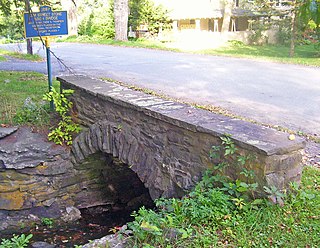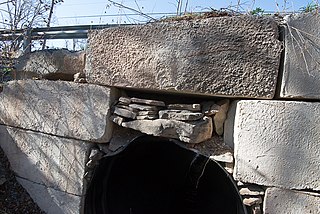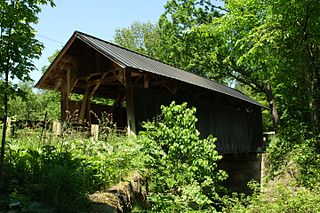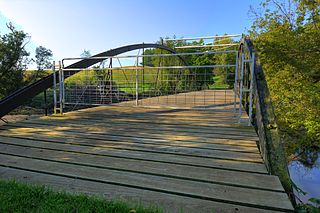
Pine Hill is a hamlet in the western part of the town of Shandaken in Ulster County, New York, United States. As of the 2010 census, the CDP had a total population of 275.

The 1841 Goshen Courthouse is located along Main Street in the center of Goshen, New York, the seat of Orange County, New York, United States. It was designed by popular local architect Thornton M. Niven in a Greek Revival style, meant to be a twin of the one he had already built in Newburgh, which at that time shared seat duties with the larger city. Construction of the building was approved by the county legislature in April 1841 and began shortly thereafter.

The Black Horse Tavern is a large stone residence at the Pennsylvania Route 116 intersection with a north-south road at Marsh Creek. The tavern was used as for approximately 65 years before 1909, the mill tract rented by William E. Myers was used as a Battle of Gettysburg field hospital.

The Elm Street Stone Arch Bridge is located along that street in Pine Hill, New York, United States. It is a short bridge built over Alton Creek in the early 20th century using stonemasonry techniques and an arch bridge design that had been employed in the Catskills since the 18th century, one. As one of the few extant and intact bridges in that style in the region, it was listed on the National Register of Historic Places in 1996 along with the nearby Mill Street Stone Arch Bridge. It is located in the Pine Hill Historic District.

The Mill Street Stone Arch Bridge is located on that street in Pine Hill, New York, United States. It is a small bridge over a local creek built around the turn of the 20th century. It is one of two stone arch bridges in the former village built by local stonemason Matthew G. Thompson. It has remained intact and in use since then, and was listed on the National Register of Historic Places in 1996. It is located in the Pine Hill Historic District.
Shady Glen Road Stone Arch Bridge, also known as Elliotts' Bridge, is a historic stone arch bridge located at Cornwallville in Greene County, New York. It was constructed in 1886 and is a single span, dry laid limestone bridge with a round arch. It spans an unnamed tributary of Catskill Creek.

The Hervey Street Road Stone Arch Bridge is a historic stone arch bridge located in Durham, New York, United States. It was constructed in 1891 and is a single span, dry laid limestone bridge with a round arch. It is 11 feet (3.4 m) wide, with a span of 14 feet (4.3 m). It spans a tributary of Thorp Creek.

Allan Teator Road Stone Arch Bridge is a historic stone arch bridge located at West Durham in Greene County, New York. It was constructed in 1892 and is a single span, dry laid limestone bridge with a round arch. It is seven feet (2.1 m) wide. It spans a tributary of Catskill Creek.

Brand Hollow Road Stone Arch Bridge is a historic stone arch bridge located at West Durham in Greene County, New York. It was constructed by Jeremiah Cunningham in 1892–1893, and is a single span, dry laid limestone bridge with a round arch. It is eight feet (2.4 m) wide, with a span of four and a half feet (1.4 m).
Moore Road Stone Arch Bridge is a historic stone arch bridge located at Cornwallville in Greene County, New York. It was constructed in 1887, and is a single-span, dry laid limestone structure with a round arch. Jeremiah Cunningham was the builder.

Dock Hill Road Extension Stone Arch Bridge is a historic stone arch bridge located at Cornwall on Hudson in Orange County, New York. It was built about 1870.

Ruhle Road Stone Arch Bridge was a historic stone arch bridge located at Malta in Saratoga County, New York. It was constructed about 1873 and spanned the Ballston Creek. The arch measured 26 feet from the creek surface and 23.5 feet between the abutments.

Pilgrim's Progress Road Bridge is a historic stone arch bridge located at Rhinebeck, Dutchess County, New York. It was built about 1858 and is a triple arch stone masonry structure built of mortared random fieldstone.

Quinlan's Covered Bridge, also called the Lower Covered Bridge, and Sherman Covered Bridge is a wooden covered bridge that crosses Lewis Creek in Charlotte, Vermont on Monkton Road. It was listed on the National Register of Historic Places in 1974. It is one of nine 19th-century Burr arch covered bridges in the state.

The Seguin Covered Bridge, also called the Upper Covered Bridge and the Sequin Covered Bridge, is a wooden covered bridge that crosses Lewis Creek in Charlotte, Vermont on Roscoe Road. It was built about 1850, and is a distinctive variant of a Burr arch design. It was listed on the National Register of Historic Places in 1974.

The Gilsum Stone Arch Bridge carries Surry Road over the Ashuelot River in Gilsum, New Hampshire. Built in 1862–63, it is one of the highest stone arch bridges in the state. It has a span of 47 feet 8 inches (14.53 m), and an average height over the river of 36 feet 6 inches (11.13 m). The roadway is 43 feet 6 inches (13.26 m) above the riverbed. It stands on the site of four previous bridges, where the river passes through a deep gorge. The previous bridge was also a stone arch bridge, which was built in 1860 and collapsed a few months later. It was designed by William Leonard Kingsbury, a local official; its builders are not known because the town's records were destroyed in a fire. The present bridge's vault is carefully constructed from dry-laid granite voussoirs that were shaped for a very precise fit, with larger stones at the lower ends of the arch, and a smaller ones at the crown. Some of the stones were left with rough surfaces, while others were hammered smooth.
The Old Cochrane Road Bridge is a historic bridge in rural Deuel County, South Dakota. It is a small single-span stone arch bridge, located on an old alignment of the road that circles Lake Cochrane. The bridge spans a stream that enters the lake near its southwestern corner, and is now located on a private lakefront property with a cabin. The bridge is fashioned from a variety of unworked fieldstone, and rises about 4 feet (1.2 m) above grade, with a span of about 6 feet (1.8 m). The bridge's date of construction is unknown, but is surmised to have been in the first decade of the 20th century. It is the only known stone arch bridge to predate the 1930s in the state.

The West Townshend Stone Arch Bridge carries Round Hill Road across Tannery Brook in the village of West Townshend, Vermont. Built about 1910, it is one of the few surviving bridges of a group built by local mason James Otis Follett in the early 20th century. It was listed on the National Register of Historic Places in 1977.

Pine Hill Historic District is a national historic district located at Pine Hill, Ulster County, New York. It encompasses 125 contributing buildings, 3 contributing sites, 2 contributing structures, and 1 contributing object in the hamlet of Pine Hill. It developed between about 1800 and 1962 and includes notable examples of Greek Revival, Carpenter Gothic, Italianate, Stick Style, Second Empire, Queen Anne, Colonial Revival, Classical Revival, and Bungalow / American Craftsman architecture. Located in the district are the separately listed District School No. 14, Elm Street Stone Arch Bridge, Mill Street Stone Arch Bridge, Morton Memorial Library, and Ulster House Hotel. Other notable contributing resources include the John C. Loomis House, Methodist Episcopal Church, Benjamin Franklin Cornish House, Elizabeth Smith House (1876), Orchard Park House (1882), and "The Zepher".

Lower Road Bridge is a historic structure located northwest of Anamosa, Iowa, United States. It spans Buffalo Creek for 160 feet (49 m). The King Iron Bridge and Manufacturing Co. of Cleveland erected a bowstring through arch truss and a shorter pony arch in 1878 for what was historically called Lower Road. The bridge's superstructure consists of a large stone masonry pier and abutments. It was listed on the National Register of Historic Places in 1998. The county abandoned the bridge and it is now privately owned.




















